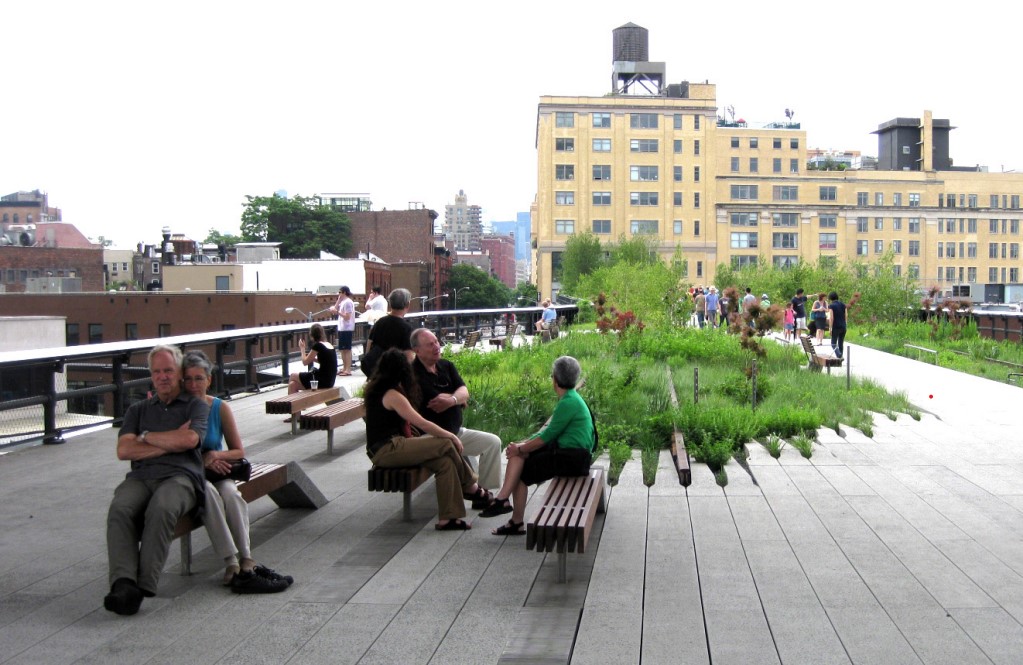
Inspired by the way indigenous plants had thrived on the abandoned rail, the designers sought to preserve that sense of natural beauty. Photo: Lisa Switkin/James Corner Field Operations
| Location | New York City, New York, USA |
| Dates | 1999-11 |
| Implementing Agency | City of New York |
| Design Firms | Diller Scofidio + Renfro, Field Operations |
| Planting Designer | Piet Oudolf |
| Engineering | Buro Happold |
| Contractor | KiSKA Construction |
| Environmental Engineer | GRB Services |
| Civil/Traffic Engineer | Philip Habib & Associates |
| Structural Engineering/Historical Preservation | Robert Silman Associates |
| Public Funders | New York City: $112.3 million USD; Friends of the High Line: $44 million USD; Federal government: $20 million USD; State of New York: $400 000 USD |
| Private Funders | The Diller-von Furstenberg Family Foundation; Christy and John Mack Foundation; The Tiffany & Co. Foundation, Pershing Square Foundation; Donald Pels & Wendy Keys; Hermine & David Heller, Michael & Sukey Novogratz, Philip A. & Lisa Marie Falcone; Adam & Brittany Levinson |
| Phase 1 Cost | $86.2 million USD |
| Phase 2 Cost | $66 million USD |
| Total Cost | $152.3 million USD |
| Length | 2.33 km/1.45 mi |
| Pedestrian Traffic | 5000 to 20 000 people daily |
New York City’s High Line has undergone a dramatic transformation over the last 80 years. It opened in 1934 as a highly celebrated elevated railway for trains carting goods from the city’s factories through Chelsea and the meatpacking district. Today, it’s a jewel of the city—an artfully landscaped public space with walking paths and greenery.
More than a beautiful park, the High Line is an example of successfully bringing a wide range of stakeholders together around the transformation of a contentious landmark. When the last train departed the High Line carrying a load of frozen turkeys in fall of 1980, train buff and actor Peter Obletz spent every cent he had trying to save it from being demolished. Obletz’s vision was to revitalize freight operations and bring passenger trains to the High Line, however he died in 1996 while the embattled railway’s fate was still in limbo and property owners and developers were fighting to tear it down.
Friends of the High Line was formed in 1999 to preserve the railway. It was a long battle of lawsuits, campaigning and fundraising, but construction started in 2006, and the first phase, spanning from Gansevoort Street to West 20th Street, opened in 2009. The second section, from West 20th Street to West 30th Street opened in the spring of 2011.
In 2005 a competition was held for the redesign of the railway, and the architect and landscape architecture firms of James Corner Field Operations and Diller Scodfidio + Renfro won the bid to transform the High Line into a public park. Funded by the grass roots, nonprofit organization Friends of the High Line, and the city of New York as well as by private donors, the project is widely lauded as an overwhelming success.
Saving the High Line
A timeline of stakeholder engagement
1851-1929
Tenth Avenue becomes known as “Death Avenue” because of the number of accidents involving freight trains and street-level traffic. Men on horses called the West Side Cowboys ride before trains waving red flags to improve safety.
1929
The West Side Improvement Project, which includes the High Line, is approved. The project cost $175 million USD in the 1930’s.
1934
Trains begin using the High Line, an elevated railway running south from 34th Street to Gansevoort Street, about 9 meters (30 ft) above New York City’s meatpacking district.
1950’s–60’s
Growth in trucking causes less trains use and in 1960 the southern-most portion of the High Line is demolished.
1980
The High Line shuts down. After a decade of declining use, the last train hauls away frozen turkeys a few weeks before Thanksgiving.
1983
Consolidated Rail Corporation (Conrail) puts the High Line up for sale. Congress passes the National Trails System Act, allowing inoperative rails to be used as recreation space.
1984
Conrail files an intent to abandon the High Line when no government agencies come forward to purchase it. Actor and train enthusiast Peter Obletz buys the rail for $10 in hopes of revitalizing train operations.
1987
The Interstate Commerce Commission (ICC) reverses the sale to Obletz after it is opposed by local and state agencies, Chelsea Property Owners (38 landholders gunning for demolition) and a development company planning to build a highway on the lower west side.
1992
The Interstate Commerce Commission commits to declaring the High Line “adversely abandoned” and will approve its demolition if Chelsea Property Owners can ensure costs exceeding $7 million (Conrail’s maximum obligation) will be covered.
1996
High Line champion Peter Obletz dies of cancer on May 4, 1996 at the age of 50.
1997
Through a merger and acquisition of Conrail with CSX Transportation Inc. and Norfolk Southern Railway ownership of the High Line passes to CSX Transportation Inc.
1999
Robert Hammond and Joshua David meet at a community meeting about its proposed demolition. They decide to start the nonprofit Friends of the High Line to save it.
The pair’s first two objectives are to file a lawsuit challenging the demolition order by Chelsea Property Owners and conduct an economic feasibility study for the High Line. They register a free Yahoo e-mail account—a key step in maintaining community support— that today has 10 000 contacts. It will take six years to gather the signatures needed to apply for a Certificate of Interim Trail Use from the federal Surface Transportation Board.
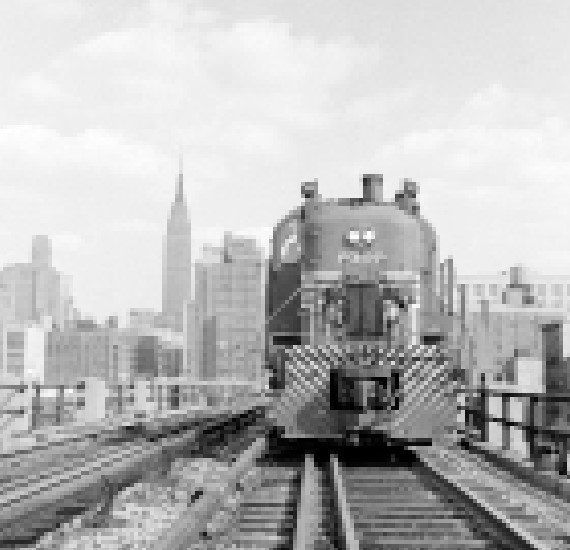
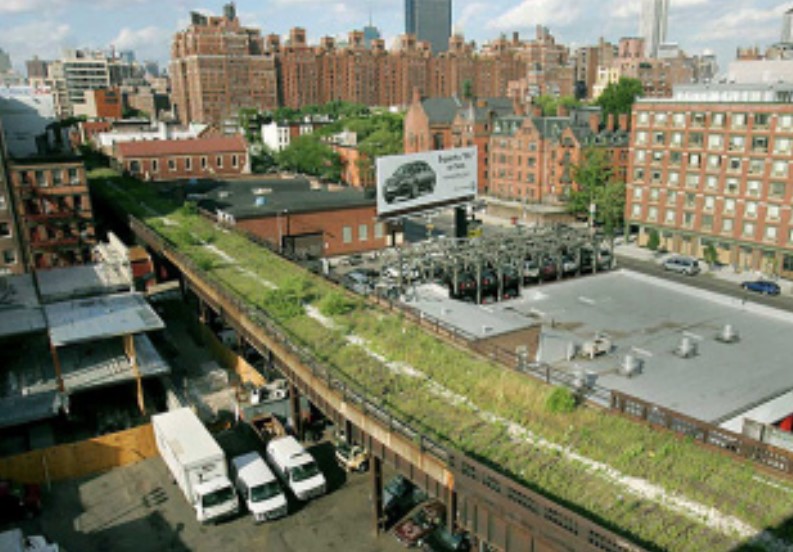
Train chugging along on the High Line in 1953. Photo: James Shaughnessy/courtesy of Friends of the High Line
High Line during shutdown. Photo: Justine Heilner/James Corner Field Operations
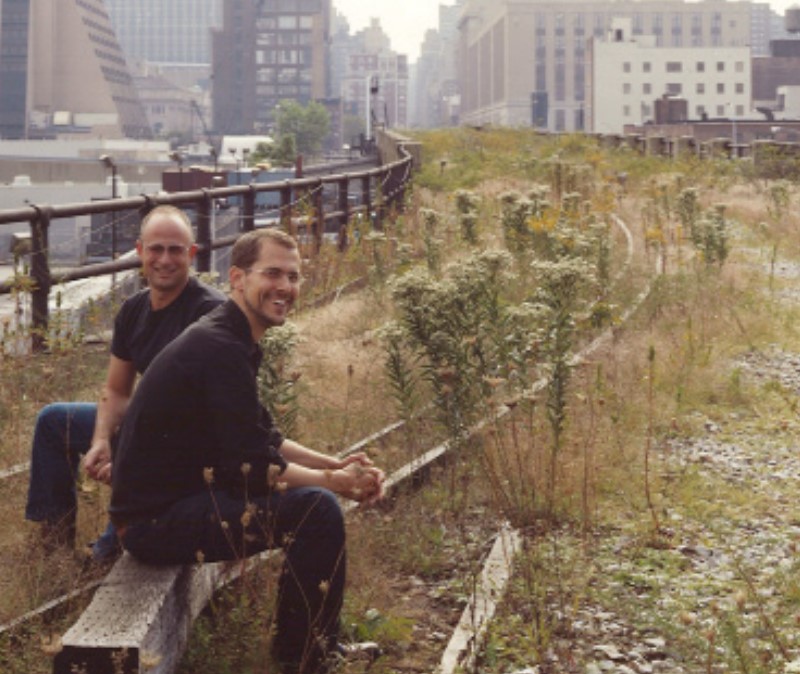
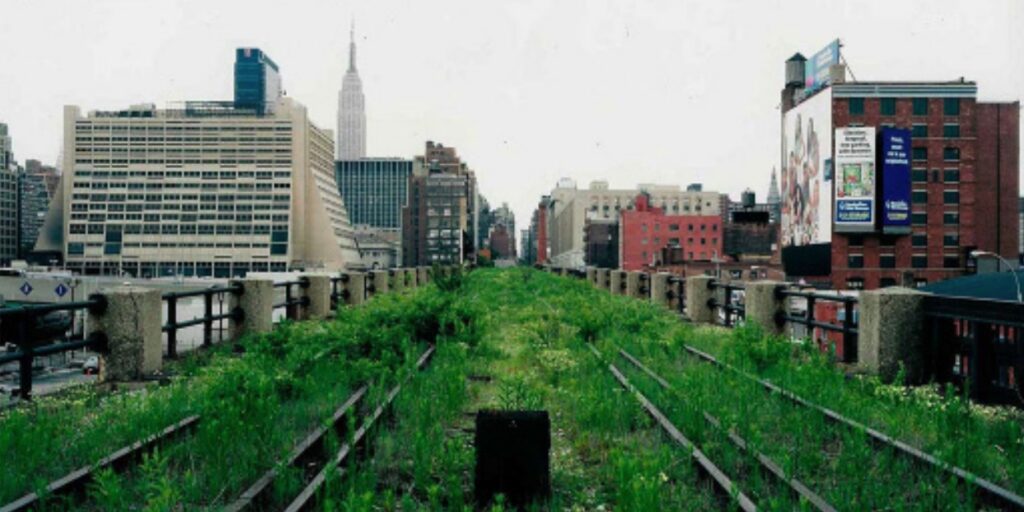
Friends of the High Line founders Joshua David and Robert Hammond. Photo: Joel Sternfield/Luhring Augustine, New York
High Line, before. Photo: Joel Sternfield/Luhring Augustine, New York
2000
The fight to stop the High Line from being demolished gets the attention of three key people who will have significant roles in its preservation.
Amanda Burden, then a member of the New York City Planning Commission, then-City Council member Gifford Miller, and well-known photographer Joel Sternfeld all go to bat for the High Line. Sternfeld photographs the High Line for Friends of the Highline’s promotional materials.
Chelsea Property Owners ramps up efforts to get funding for the demolition.
2001
Actor Edward Norton sees Sternfeld’s work in The New Yorker. He becomes the first of many celebrities to support the High Line.
On December 20, his last day in office, Mayor Rudolph Giuliani signs an agreement with Chelsea property owners and others, consenting to the abandonment and demolition of the High Line.
Acting on an earlier petition filed a month before by the New York City Council, Manhattan Borough President C. Virginia Fields, six Chelsea residents and Friends of the High Line, a judge issues an injuction haulting the demolition on the grounds that related property easements along the route of the viaduct should have been subject to the city’s uniform land use review procedure.
2002
Michael Bloomberg, a High Line supporter, is elected mayor of New York City. He appoints Amanda Burden chair of the city’s Planning Commission. Gifford Miller is elected speaker of the city council. Miller uses his new post to access funds for the High Line and moves to rezone the area so owners of properties beneath it will be able to sell their air rights, thus raising property values. This plan will be completed in 2005.
In February 2002, Friends of the High Line releases Reclaiming the High Line, a comprehensive reuse and planning study, co-sponsored by The Design Trust For Public Space.
The Design Trust for Public Space offers a fellowship to architect Casey Jones to do a planning study for the re-use of the rail line.
Martha Stewart and Edward Norton co-chair a Summer Benefit Party for Friends of the Highline. It will become a regular high-profile event.
2003
Fashion designer Diane von Furstenberg hosts a launch party for a design competition by Friends of the Highline. It garners 760 entries from 36 countries. The jury includes designers, city planners and business owners.
Friends of the High Line receives 1500 individual donations even before publishing the winning concept design. On July 22, the city commits $15.75 million in funding for the High Line’s conversion to public space.
2004
Three major announcements help secure the High Line’s preservation. New York City increases its funding to over $43 million. The state of New York and Conrail support the city’s request to rail-bank the High Line. Landscape architecture firm Field Operations is hired along with design firm Diller Scofidio + Renfro to create the High Line’s master plan.
2005
Re-zoning of the West Chelsea neighborhood is completed, enabling new commercial and residential growth.
The High Line gets a Certificate of Interim Trail Use and ownership is transferred to the city of New York. Development for public use can finally begin.
2006
The High Line redevelopment breaks ground on April 10.
2009
Section 1 of the High Line Opens.
2011
Section 2 of the High Line Opens.
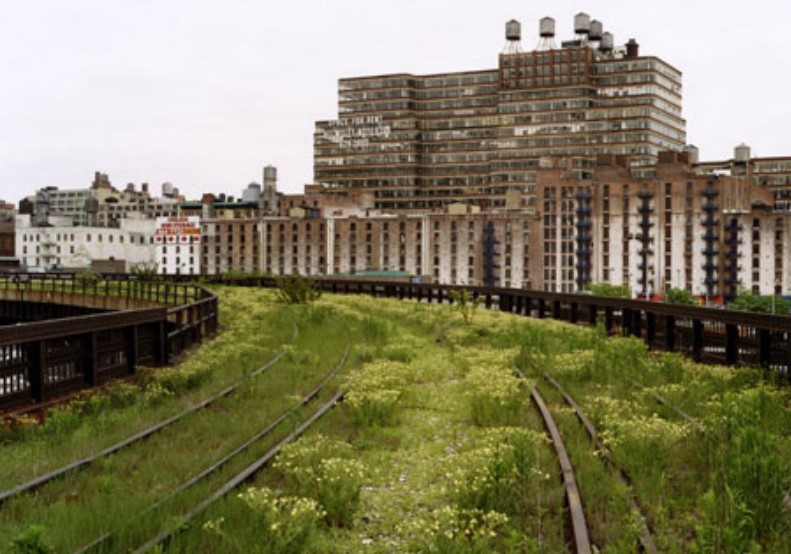
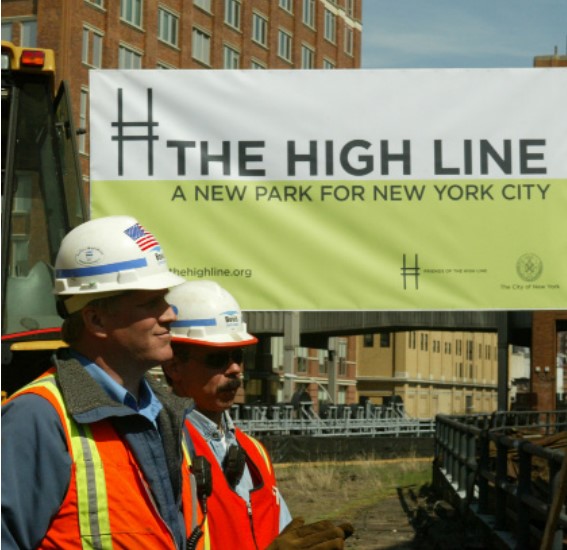
High Line (before). Real estate values soared after the railway was reopened to the public. Photo: Joel Sternfield/Luhring Augustine, New York
Construction Workers watch the groundbreaking ceremony of the High Line redevelopment project. Photo: Edward Reed/City of New York
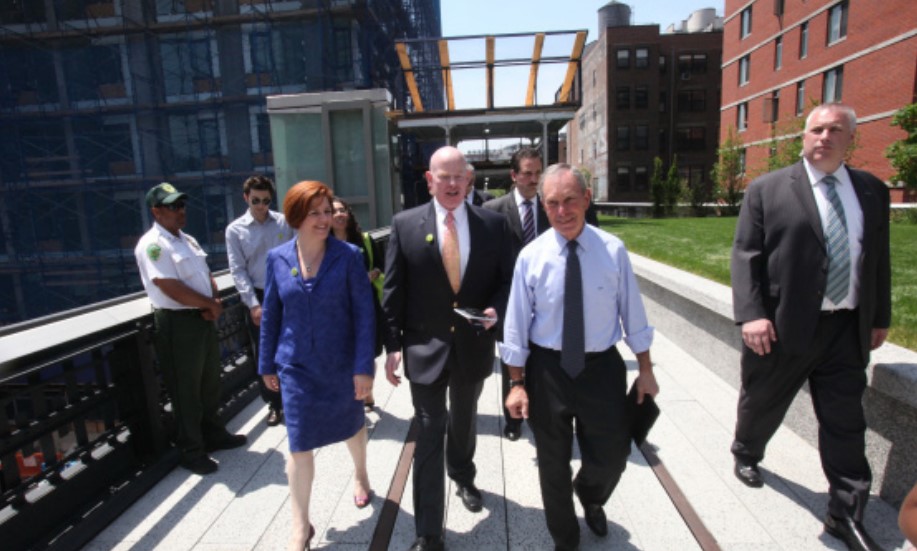
Mayor Bloomberg at the Section 2 opening. Photo: Friends of the High Line















READ OR LEAVE A COMMENT